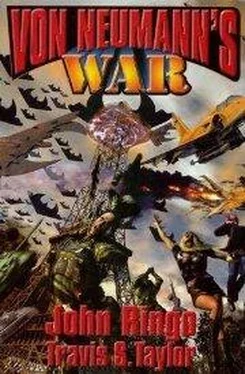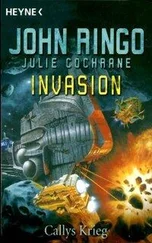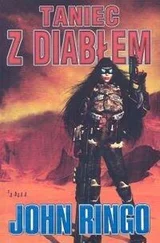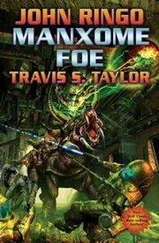SCADA, or Supervisory Control and Data Acquisition systems, weren’t actually full control systems or Internet connections. Instead SCADA systems were typically designed for use on the supervisory level. Fortunately, most supervisors would rather use Internet connectivity and simple browsers to supervise such systems. It was just easier for them.
Richard knew that the good thing about SCADA control systems was that they were basically all software that had been overlaid on top of a networked hardware system. SCADA was a fairly common and commercial approach that used COTS devices that could be interfaced and programmed easily. Their robustness and versatility had made them quite popular as the programmable logic control system of choice since early 2000. Not only were they used for railroads and factories, SCADA systems were ideally suited for any large manufacturing facility that had thousands of input/output interface requirements, such as car manufacturing plants, nuclear plants, power generation and transfer plants, and even some airport systems.
Unfortunately, the only one that came near the Appalachian Mountain chain that Richard could find was the railroad system. It was easy enough to hack into since there was little need for network security from bears and raccoons. Most of the older SCADA systems ran on DOS, VMS and UNIX; this one used UNIX. Richard spoke UNIX just fine. So he hacked in and got connected and then only had to drag a line back to the river, then through an access shaft to the mine. The portion running up to the access shaft was pure optical cable, so the bots should leave it alone.
Thus Richard had eight different routes to gain Internet connectivity. Once he had identified his closest Internet service provider locations, he either set up accounts or hacked into the cables. Mostly he hacked into the systems by splitting the cables at junction boxes. Where he could get line of sight he set up lasercom relay systems to the river and then he dropped cable downriver to the mine. This all sounded simple, but it actually involved several months of very tedious and sometimes clandestine work. He also found that he had to run power cables up to the edge of the river to power the lasercom systems. Fortunately, he only ended up using three different lasercom routes and was able to drop cable all the way from the other six connections.
Bandwidth was his big problem. He knew the long drops would only supply low bandwidth connections. He hoped to mitigate that with a couple of different approaches. The first was to multiplex the eight different connections, thus effectively increasing his bandwidth by sending IP packets out sequentially on dynamic IP addresses. This would help some.
The other way he planned to increase his bandwidth was by placing a big amplifier at each end of the connections. Under normal circumstances the companies would have eventually found the hacks, but nothing about nowadays was normal. Richard was planning on the companies basically dropping out of customer service and such matters altogether. So looking for hacks would be low on their lists of things to do. And if they did find them all, which he doubted, he would fall back on bursting transmissions through the amateur radio repeater networks. But there was still something nagging him about that.
Thinking about the repeater networks made him subconsciously look at the rope light to make sure the coaxial cable from the radio transceiver antenna was still running along beside it. It was. As a last ditch effort he could use the amateur radio network to com-municate and connect to the world. But he was not even going to turn that system on if he didn’t have to. Radio… he still wasn’t sure, but there was something about radio that made him nervous. Radio and telecom seemed to be the first thing to go at Mars, the Moon, around the planet. Was there something about radio? Most all telecommunications that were left on the globe now were over the Internet. There were occasional burst transmissions of radio sent from Australia, South America, parts of Africa, and still here in the United States, but they were limited. As soon as he got set up, he was going to do a full analysis on the RF spectrum and see if he could figure that out.
He continued to talk himself through his things to do and after about eight minutes of walking he finally made it to the entranceway to the shelter. He shined his light up and down the walls of the mine shaft at the doorway he had built. He was quite pleased with his handiwork. He was somewhat displeased with the empty red wagon parked beside the doorway. Richard punched in the code on the cipher lock and pushed the door open. He tapped the battery-operated light by the door and illuminated the front room of his shelter.
The front room was nothing more than a section of the mine shaft about fifty feet long. There were three other shafts on the right side of the main section and one on the left. Between the shaft entrances on the right were plastic garage storage shelves with every inch of space filled judiciously with plastic storage bins, cardboard boxes with various item titles handwritten on the side in marker, and various other hardware and supplies.
On the left side of the main tunnel were more shelves and some folding tables. On the folding tables were a coffee maker, a microwave, a hotplate, a blender, and a toaster oven. There were folding chairs placed in front of the tables. Near the entrance to the left-side shaft was also a large plastic shop sink. There was a plastic gallon container with a pump dispenser top marked “antibacterial soap” sitting on a shelf beside the sink. Two one-inch pieces of PVC pipe ran up the mine wall behind the sink and turned down the left-side wall of the entranceway to the shaft on that side of the main room. Alongside where those pipes entered the shaft were several other one-inch PVC pipes that came out of the entranceway and ran across the top of the shaft and over to the other side entrances. A green garden hose ran out of the bottom of the sink, then along the bottom side of the shaft and out the left side. There were several other garden hoses meeting at that left-side entranceway.
On the other side of the shaft entrance — the one on the left side of the main chamber — were several bundles of Cat-5 cable and several very thick high amperage electrical power cables running along the corner of the wall. Richard tapped another couple of battery powered lights and followed the left shaft.
About twenty feet down the shaft the sound of running water became overwhelming. Richard continued to tap lights on the wall of the shaft. He had placed them much more densely in this tunnel. Under most of the lights were more folding tables with various pieces of equipment stowed in boxes. There were also a few large plastic bins stacked on top of each other. On the left side of the shaft, about half the way down it, a PVC pipe ran into a sixty-gallon water heater. The inflow pipe to the water heater continued down the hall with the rest of the pipes.
There was also a five-shelf plastic garage storage rack on the right side of the shaft with router and switching hardware. They were not powered presently. Eight coaxial cables came in to the hardware from further down the shaft. Several Cat-5 cables were connected to a bank of hubs. The Ethernet cables then ran back out toward the way he had come in.
Finally, he reached the end of the shaft at an old rusty metal pier and ladder. The PVC pipes all connected into a string of tees that were converted to two-inch PVC that was then converted again three different times until it was finally an eight inch pipe that ran upward alongside the ladder. The large pipe was zip-tied to the ladder. The bundle of coaxial cables wound around the pipe and upward.
He stepped out on the pier and shined his light across the large underground chamber. The chamber had to be at least thirty feet across in any direction and at the bottom, which was another twenty feet below him, was a small freshwater pond that was several feet deep in the middle. He knew because he had surveyed it several times with snorkeling gear. In the light there was a flash of silver as the small trout he’d stocked reacted to his presence. People meant food to the little trout. When they were larger, the reverse would be true.
Читать дальше












